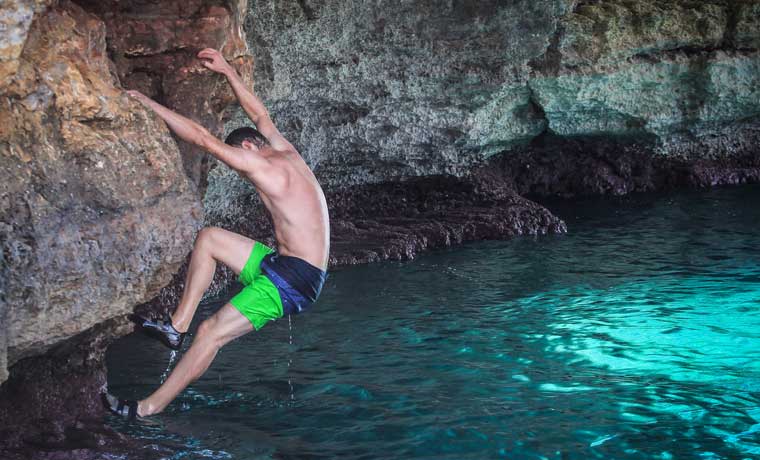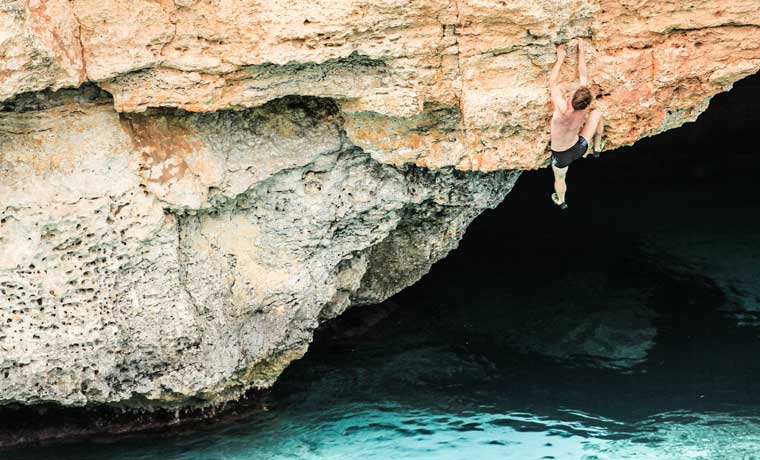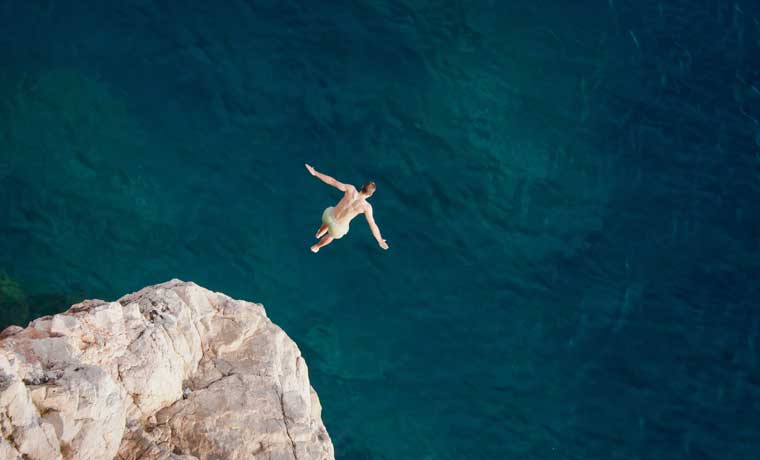To put it simply, deep water soloing (or psicoblock as it’s sometimes called) is all the fun of climbing with pure hands on rock and a willingness to freefall into the water below. It’s climbing without the rack and ropes over deep water, so that you can enjoy the feel of the rock against you and the sun on your back. Like coasteering, it can bring you to spots that ordinary tourists would never access, and the first deep water soloing competition was held in the UK in 2014, meaning more and more people are starting to get involved.
If you’re looking for new and inspiring places to explore the outdoors, deep water soloing opens up a world of possibilities. Imagine kayaking or paddle boarding to an incredible spot, climbing up a cliff face or rocky outcrop then making a triumphant leap from the top – that’s the kind of sensation that’s on offer. It’s a feeling of liberation that money can’t buy.
- Who is deep water soloing for?
- Where can you go deep water soloing?
- What to expect on your first deep water solo attempt
- How to get started
- What to wear for deep water soloing
- How to train for deep water soloing
- Where to learn more about deep water soloing
Check out this video for a little more inspiration…
Who is deep water soloing for?
One of the best aspects of deep water soloing is its relative accessibility. Although you do need to plan ahead, bring some equipment and take safety precautions, there’s far less expensive gear needed compared with other climbing types.
It helps if you’ve done a bit of climbing before, and although deep water soloing is genuinely adaptable to different levels, starting with baby steps is always a good idea, regardless of your climbing ability. Climbs can range between everything from dizzying heights above the water to rock scrambling a short way above the sea’s surface.
For more information about how to get into climbing, take a read of our Try Something New: Rock Climbing article.
People who love deep water soloing tend to love a little bit of adrenaline, and an activity that is low cost. Plus, they’re in it to see some of the most breathtaking spots in the world. If you’re a strong swimmer with a decent head for heights, then deep water soloing could be for you.
If you’re not exactly sure what things will be like, buddy up with someone who is experienced and knows exactly what they’re doing. If you can’t find anyone locally, there are organised tours and expert guides available that will take you out for a professionally supervised deep water soloing session.

Where can you go deep water soloing?
There are so many fantastic spots to choose from at home and abroad. Wherever there’s a stunning cliff or rocky outcrop above deep water, there could be a potential deep water soloing opportunity, depending on conditions.
But that’s not to say you can just rock up and climb wherever. The area you choose may be protected due to nesting birds and wildlife. The rock may be loose, and dangerous currents may lurk in the waters below. So until you become highly experienced, it’s best to climb in recommended spots.
Around the world some spots have become magnetic for deep water soloing lovers, such as Majorca’s coastline which has been attracting tourists to the sport since the 70s. Thailand is another famous venue, particularly Railay, and the year-round warmth of the water is a big attraction.
In the UK, there are an immense range of spots too. Devon’s Berry Head, in the South West, makes the perfect starting point. Dorset is nearby too and has great entry level options at Lulworth Cove and Stair Hole. More advanced deep water soloing fans often gravitate to Pembroke in Wales, which offers more challenging routes at places like Barrel Zawn and Range East.
For a couple of great spots in the USA, check out Climbing.com.
What to expect on your first deep water solo attempt
Expect to fall in love with the experience and want to dedicate time to trying it again!
That being said, expect and prepare to get wet! So plan to be warm and comfortable while basking in your success afterwards. Half the pleasure in the experience is topping off the exertion of the climb with the exhilaration of the plunge when you finish. But with that plunge comes the shock of being submerged in often very cold water! It’s essential that you are prepared for this and are happy swimming in cold water.
Expect also to be flexible! If the conditions when you arrive aren’t right and the tide is too choppy, you may need to call it off. Don’t worry though, deep water soloing will be worth it when the right day comes!

How to get started
A great first step would be to get comfortable with climbing itself. Researching online and watching expert videos will certainly help and give you plenty of inspiration! But nothing beats regular sessions at your local indoor climbing wall to build up your strength, technique and confidence.
Once you feel you’ve got the basics of climbing, the preparation begins. Pick your time of year (usually May-September) and get your kit together. Also check the tide carefully online and time your climb for the high tide which gives you the safety of a proper water cushion beneath you.
Next grab a friend – it’s called soloing because you can climb and jump alone but you absolutely need someone there as backup. This person needs to be ready to dive in and help if needed and to have first aid supplies, just in case. Also, you need someone to snap photos of how cool you look halfway up a cliff!
When you get to the spot, re-familiarise yourself with both the route and the water, and then get started on a route that suits your experience level. There’ll be plenty of time to push yourself with bigger and better things later!
What to wear for deep water soloing
This is where deep water soloing comes into its own with the inexpensive gear and supplies required. You don’t need designer sports gear, just sensible leisure or swimming clothes along with good climbing shoes. A dry bag is also a great idea to keep your spare clothes dry.
Remember that you’re likely to get wet – even if you’re hoping not to take a single fall, so you’ll need a spare dry set of shoes, chalk bag, chalk and clothes. The chalk is used to dry sweat from your hands and help you keep a good grip when climbing. For a really demanding route, an abseil rope is sometimes needed. Don’t forget the towels, either.
Extremely cold water can put you into shock, so do bring a few supplies for warming up such as a first aid blanket, a hot thermos full of tea and warm clothes for after the experience.
How to train for deep water soloing
The beauty of deep water soloing is that it relies more on stamina than traditional brawn and strength. Putting in the time to build up general fitness, will certainly pay off, however. And of course, getting to your climbing gym as often as possible to improve your climbing is key. There’s also a lot of really useful mental preparation you can do, and here’s where to start:
-
Stamina exercises
A really simple way to build stamina is to put some time into doing something you like, be it walking, cycling or anything else and challenge yourself with increased time increments and intensity bursts. Over time, you’ll start to see yourself pushing the barriers of what you could do before.
-
Practise spying out the area
It’s incredibly helpful for any deep water soloing attempt to have knowledge of the area. The more you know the better! Get to know that rock face like the back of your hand if need be! It’ll all be worth it when you can visualise strategies and routes that others can’t spot.
-
Get used to deep (and cold!) water
Take the fear out of the water by getting to know it from a safe level. Go on and take a dip, that way you’ll know exactly what you’re in for. Try a few jumps from different heights to see what it feels like. Do maintain a healthy respect for it, though, at very great heights landing in water can feel solid indeed, so stay within your limits, and be sure to only jump into water that you are certain is deep enough.

Where to learn more about deep water soloing
Online there is a thriving community of people who love deep water soloing and forums where you can get you can ask for support with any aspect. Talk to people at your local climbing gym, and get hold of your local guide book – this will really help with choosing the appropriate route for your climbing ability.
Also check out these resources:
- British Mountaineering Council
- www.rockclimbing.com
- UK Climbing
- www.climbing.com
Deep water soloing is just one way to challenge yourself and shake the doldrums out of everyday life. Whether it’s a weeklong getaway to the sunny shores of Majorca or Thailand, or an after work trip to your local lake or coast, it’s a superb challenge and excellent way to adventure more.
For more adventure ideas that can help you see more, do more and feel more, get inspired by the incredible adventurers at 101Adventures.com.
The post Deep Water Soloing: A Guide For Beginners appeared first on Cool of the Wild.


